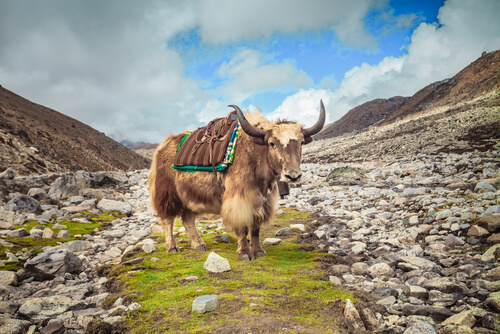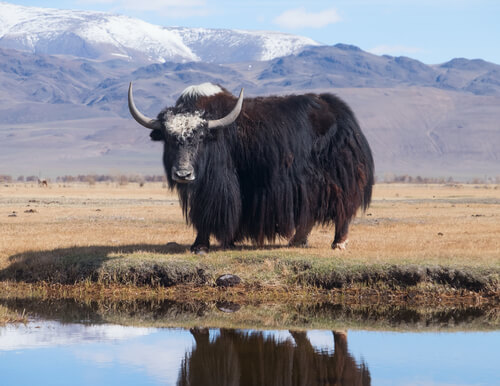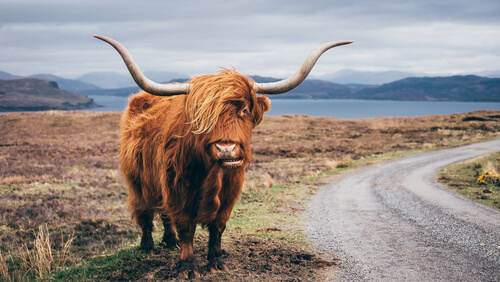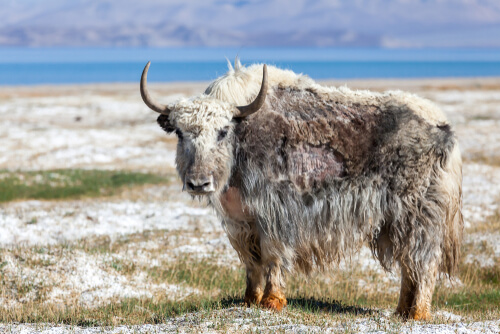
| Kingdom | Animalia |
| Phylum | Chordata |
| Class | Mammalia |
| Order | Artiodactyla |
| Family | Bovidae |
| Genus | Bos |
| Species | B. grunniens, B. mutus |
| Niche | Alpine grazer |
| Height | 5.2 – 7.2 ft (1.6 – 2.2 m) |
| Weight | 672-2,646 lb (305-1,200 kg) |
| Lifespan | 20-25 years |
| Social Structure | Herding |
| Conservation Status | Vulnerable |
| Preferred Habitat | Alpine meadows |
| Average Litter Size | 1 |
| Main Food Items | Grasses, sedges |
| Predators | Himalayan wolf, brown bears, snow leopards, humans |
The Basics
The Yak is a large ox-like mammal native to Tibet and other high-altitude regions of Asia. Here, it was domesticated and has been introduced to virtually all human settlements at a high altitude of over 14,000 feet. They are now common in China, Mongolia, Nepal, and Central Asia.

Description
The yak is a large ox or cow-like animal that can grow up to 7.2 feet tall at their shoulders. Bulls can weigh up to 1,800 pounds while cows (females) are generally about half as heavy. They are normally black, brown, white, or grey in color and have varying lengths of coat depending on the population. In China, for example, they are heavily fringed with a long black overcoat over their shorter undercoat, normally black or brownish in color. Yaks have a drooping head in front of their large shoulders with large horns of up to 30 inches long in males.
Wild yaks (Bos mutus) and domesticated yaks (Bos grunniens) are generally considered distinct species, although they are still able to freely interbreed. Domestic yaks are generally smaller than their wild counterparts, normally weighing about 30% less. They also tend to have a larger variation in coat color than wild yaks.
Distribution and Habitat
Yaks are native to high-altitude regions of Tibet such as the Tibetan Plateau. Currently, they are found throughout the world in high-altitude environments, primarily in China, Mongolia, Nepal, and Central Asia.
Wild yaks tend to form medium-sized herds of about 25 individuals. Males are often more reclusive than others, often spending most of their time alone or in small groups of other bachelors.
Diet and Predators
Yaks normally migrate to lower plains during winter months where they can continue to graze on grasses and sedges. During the summer they will return to the plateau where it is cooler. Here they tend to feed more on mosses and lichens which they can scrape from rocks with their rough tongues. For much of the year, water is scarce in the yak’s snowy and frozen environment. To stay hydrated, yaks will eat snow when necessary.

Due to their large size, adult yaks have few natural predators. Historically, yaks have been hunted by the Himalayan Wolf which uses its pack hunting abilities to attack the large ruminant. More recently, accounts of Snow Leopards and Brown Bears hunting yaks have also been reported. In most cases, it appears these animals will target young, weak, or injured individuals. Like most wild species, wild yaks have also been hunted extensively by humans.
Reproduction
The breeding season beings in late summer. At this time, yaks tend to form larger herds than during the rest of the year, and solitary males and bachelor groups will also join the herd.
Following copulation, females experience a gestation period of about nine months, normally giving birth to a single calf late the following spring or early summer. Females will nurse calves for up to a full year before weaning them. That fall, roughly two years after her previous pregnancy began, females will normally breed again.
Conservation
Although domesticated yaks are numerous throughout the world, their wild counterparts are somewhat less common. This is due largely to the fact that they were hunted nearly to extinction in Tibet during the 1900s, mostly by Tibetan and Mongolian herders and military personnel. Currently, small populations remain in northern Tibet as well as on the Ladakh steppe of India. Although they are listed as Vulnerable on the IUCN Red List of Threatened Species, they remain effectively unprotected. They are further endangered due to their ability to interbreed with domestic cattle.
Fun Facts about the Yak!
Although wild yaks are increasingly rare, domestic yaks remain abundant in high-altitude environments where humans have settled. These species are still able to interbreed, highlighting just one of the fun facts and biological concepts that can be explored via the yak.
Rain Coat
Most yaks have a multi-layered coat. Their thick, short undercoat is an excellent insulator, capable of keeping yaks warm in their extreme winter environments. However, much like a down jacket made of goose down, this undercoat will not serve its function well when it gets when. Therefore, their overcoat of longer, coarse fur is just as important in keeping the animal warm as it acts as a protectant waterproofer of the undercoat. This combination allows the yak to survive in temperatures regularly as low as minus 40 degrees Fahrenheit.

Biofuel in the Himalayans
The Tibetan Plateau is a harsh and sparsely populated environment. However, humans have existed here in some numbers for many centuries. Due to its harsh and cold environment, the entire region is effectively devoid of trees and other vegetation. Therefore, the yak has become a lifeline in many ways, including in keeping people warm.
Not only are their hides and fur harvested for insulating clothing, the dried dung of yaks – the only fuel available on the Tibetan Plateau – is also of great value. In fact, the availability of yak dung as fuel was a potentially critical factor in the eventual colonization of this harsh environment. The need for this fuel was so great that it may have been the root cause of wild yaks being integrated into human settlements, ultimately leading to its domestication.
Unclear Roots
The exact history of the domestication of the yak remains unknown. However, current historical evidence suggests that following their integration into human settlements due to the need for their dung, they were likely first bred to help transport supplies for human caravans traveling early Himalayan trade routes.
Today, there are likely about 12 million domesticated yaks in the world. Known as being docile and easily persuaded, they are now bred for their high volumes of milk production as well as for farm work, wool, and meat.
Full of Hot Air
In an environment known for its harsh winter conditions and high altitudes, the yak had various natural evolutionary adaptation that helped it to thrive here. Besides its size, strength, and hardy winter coat, it also has the ability to make the most of the air in its low-oxygen environment due to its massive lung capacity and many small red blood cells.
In comparison with common cattle, the lung capacity of yaks is about three times as large. This allows them to take in more air in each breath which makes up for the lack of oxygen present in their high-altitude environment. In addition, they also have more and smaller red blood cells than comparable mammals that live in low-altitude environments. This allows for the transport of more oxygen per volume of blood than would otherwise be possible. In combination, these adaptations allow the yak to extract more oxygen from the air in its environment than would otherwise be possible, clearly making it well suited for its high-altitude alpine environment.
